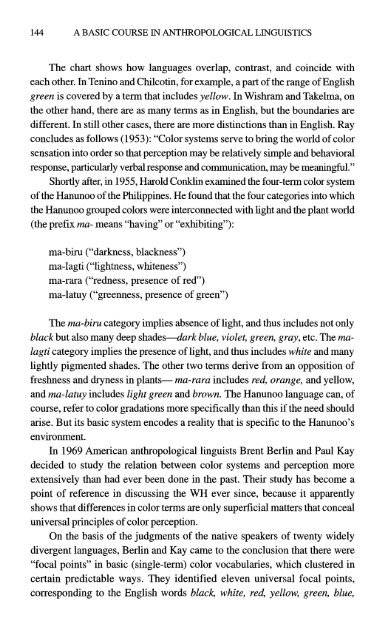A Basic Course in Anthropological Linguistics (Studies in Linguistic ...
A Basic Course in Anthropological Linguistics (Studies in Linguistic ...
A Basic Course in Anthropological Linguistics (Studies in Linguistic ...
Create successful ePaper yourself
Turn your PDF publications into a flip-book with our unique Google optimized e-Paper software.
144 A BASIC COURSE IN ANTHROPOLOGICAL LINGUISTICS<br />
The chart shows how languages overlap, contrast, and co<strong>in</strong>cide with<br />
each other. In Ten<strong>in</strong>o and Chilcot<strong>in</strong>, for example, a part of the range of English<br />
green is covered by a term that <strong>in</strong>cludes yellow. In Wishram and Takelma, on<br />
the other hand, there are as many terms as <strong>in</strong> English, but the boundaries are<br />
different. In still other cases, there are more dist<strong>in</strong>ctions than <strong>in</strong> English. Ray<br />
concludes as follows (1953): “Color systems serve to br<strong>in</strong>g the world of color<br />
sensation <strong>in</strong>to order so that perception may be relatively simple and behavioral<br />
response, particularly verbal response and communication, may be mean<strong>in</strong>gful.”<br />
Shortly after, <strong>in</strong> 1955, Harold Conkh exam<strong>in</strong>ed the four-term color system<br />
of the Hanunoo of the Philipp<strong>in</strong>es. He found that the four categories <strong>in</strong>to which<br />
the Hanunoo grouped colors were <strong>in</strong>terconnected with light and the plant world<br />
(the prefix ma- means “hav<strong>in</strong>g” or “exhibit<strong>in</strong>g”):<br />
ma-biru (“darkness, blackness”)<br />
ma-lagti (“lightness, whiteness”)<br />
ma-rara (“redness, presence of red”)<br />
ma-latuy (“greenness, presence of green”)<br />
The ma-biru category implies absence of light, and thus <strong>in</strong>cludes not only<br />
black but also many deep shades-dark blue, violet, green, gray, etc. The ma-<br />
lugti category implies the presence of light, and thus <strong>in</strong>cludes white and many<br />
lightly pigmented shades. The other two terms derive from an opposition of<br />
freshness and dryness <strong>in</strong> plants- mu-ruru <strong>in</strong>cludes red, orange, and yellow,<br />
and ma-lutuy <strong>in</strong>cludes light green and brown. The Hanunoo language can, of<br />
course, refer to color gradations more specifically than this if the need should<br />
arise. But its basic system encodes a reality that is specific to the Hanunoo’s<br />
environment.<br />
In 1969 American anthropological l<strong>in</strong>guists Brent Berl<strong>in</strong> and Paul Kay<br />
decided to study the relation between color systems and perception more<br />
extensively than had ever been done <strong>in</strong> the past. Their study has become a<br />
po<strong>in</strong>t of reference <strong>in</strong> discuss<strong>in</strong>g the WH ever s<strong>in</strong>ce, because it apparently<br />
shows that differences <strong>in</strong> color terms are only superficial matters that conceal<br />
universal pr<strong>in</strong>ciples of color perception.<br />
On the basis of the judgments of the native speakers of twenty widely<br />
divergent languages, Berl<strong>in</strong> and Kay came to the conclusion that there were<br />
“focal po<strong>in</strong>ts” <strong>in</strong> basic (s<strong>in</strong>gle-term) color vocabularies, which clustered <strong>in</strong><br />
certa<strong>in</strong> predictable ways. They identified eleven universal focal po<strong>in</strong>ts,<br />
correspond<strong>in</strong>g to the English words black, white, red, yellow, green, blue,






